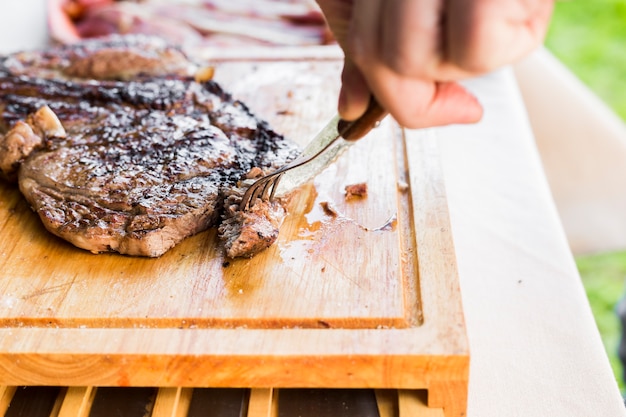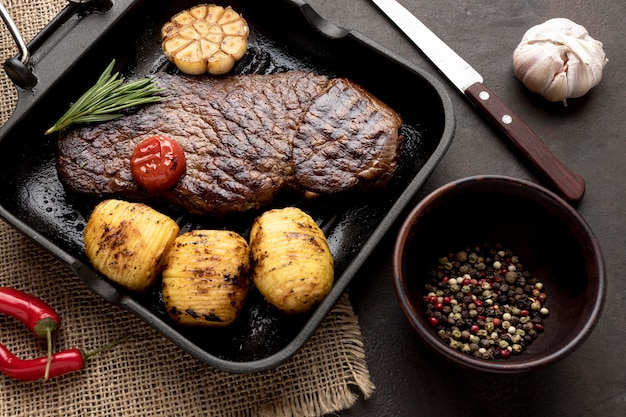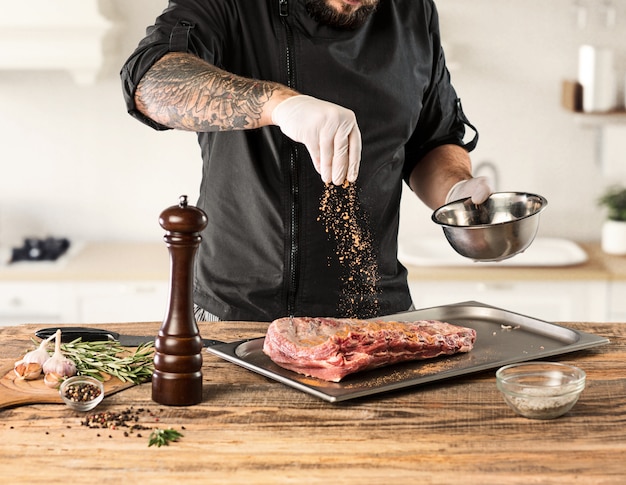I’m not going to lie, I'm a bit of a steak snob. I love the smoky char of a grilled steak, the sizzle of a pan-seared one, but nothing quite beats the perfect oven-baked steak. It’s a method that allows for incredible tenderness, consistent doneness, and a beautiful crust, all without the fuss of constantly tending to a hot grill or pan.
This guide will walk you through every step, from choosing the right cut to perfecting the art of resting, so you can impress your friends and family with mouth-watering, restaurant-quality steak at home.
(Part 1) Choosing Your Steak: The Foundation of Flavor

The Cut: A Matter of Preference
Choosing the right cut is like picking the right canvas for your masterpiece. Here’s my take on the most popular choices, with a few personal opinions thrown in:
Rib-eye: My absolute favorite! The beautiful marbling, the generous amount of fat, it’s a recipe for melt-in-your-mouth tenderness and rich, deep flavor. If you’re looking for a steak that practically begs for a good pat of butter, this is the one.
strip steak (new york strip): This cut is leaner than a rib-eye, with a bit more firm texture. It’s still incredibly flavorful and perfect for those who prefer a slightly lighter steak.
Sirloin: A good all-rounder, sirloin offers a good balance of flavor and tenderness at a more affordable price point. It’s also a fantastic cut for those who like a good char.
Tenderloin (filet mignon): The ultimate in tenderness, filet mignon is a decadent choice, but it can be pricey. It's best used for smaller portions or thinly sliced steaks.
The Thickness: Achieving Even Cooking
Think of thickness as the key to consistent doneness. I always go for a steak that’s at least 1.5 inches thick. It allows for even cooking and ensures a juicy, satisfying bite every time.
The Quality: The Difference Between Good and Great
There's no shortcut when it comes to quality. Invest in high-quality beef, preferably aged for at least 21 days. The aging process tenderizes the meat and develops deeper, richer flavors.
(Part 2) Preparing Your Steak: Setting the Stage for Success

Seasoning: Simple Yet Powerful
I keep my seasoning simple, focusing on the true star of the show: the flavor of the beef itself. Salt and pepper are all you really need, but feel free to experiment with other spices for a personalized touch.
Salt: It’s crucial for bringing out the natural flavors of the steak and creating a beautiful, crispy crust. I prefer kosher salt because it’s less salty than table salt, allowing you to control the saltiness better.
Pepper: Freshly ground black pepper adds a delightful kick. You can also experiment with other spices like garlic powder, onion powder, or paprika, but remember, a little goes a long way!
Resting: Bringing the Steak to Room Temperature
Before you even think about touching the oven, let your steak rest at room temperature for at least 30 minutes, preferably an hour. This allows the meat to come to room temperature, ensuring even cooking. Think of it as a warm-up for the steak.
(Part 3) Baking Your Steak: The Heart of the Process

Preheat Your Oven: Getting Ready for the Big Bake
Preheat your oven to 400°F (200°C). This high temperature ensures that the steak cooks quickly and evenly, achieving that coveted crust without overcooking the inside.
Searing (Optional): Adding Depth of Flavor
Searing is a bit of a personal preference, but it’s a great way to add extra depth of flavor and a truly irresistible crust.
The How-To: Heat a heavy-bottomed pan (cast iron is ideal) over high heat. Add a tablespoon of oil and let it shimmer. Once hot, sear the steak for 1-2 minutes per side, just enough to give it a nice color and a crispy crust.
Baking: The Final Stage
Place your steak on a baking sheet or in a roasting pan. For added succulence, you can add a few tablespoons of water to the bottom of the pan to create a steamy environment that will help keep the steak moist. Bake for:
Medium-rare: 10-15 minutes
Medium: 15-20 minutes
Medium-well: 20-25 minutes
Checking for Doneness: The Art of Precision
This is where a meat thermometer becomes your best friend. Insert it into the thickest part of the steak, making sure it doesn't touch bone, and use these guidelines:
Rare: 125-130°F (52-54°C)
Medium-rare: 130-135°F (54-57°C)
Medium: 135-140°F (57-60°C)
Medium-well: 140-145°F (60-63°C)
Well-done: 145-150°F (63-65°C)
Resting Again: The Secret to Juiciness
After baking, let your steak rest for at least 5-10 minutes before slicing. This allows the juices to redistribute throughout the steak, resulting in an incredibly tender and juicy bite.
(Part 4) Serving Your Steak: A Culinary Triumph
Slicing: Mastering the Technique
Slice your steak against the grain. This means slicing across the direction of the muscle fibers, making the steak more tender and easier to chew.
Accompaniments: The Perfect Pairings
The beauty of a steak is its versatility. Choose your favorite accompaniments:
Starchy Sides: mashed potatoes, baked potatoes, roasted potatoes, risotto...the possibilities are endless!
Vegetable Sides: Roasted vegetables, grilled asparagus, sauteed mushrooms, creamed spinach...let your imagination run wild.
Fresh and Light: A simple green salad, a light vinaigrette, a side of fruit…balance the richness of the steak.
Sauce: The Finishing Touch
A little bit of sauce can elevate your steak to a whole new level. Here are a few of my favorites:
Classic Béarnaise Sauce: A rich, creamy sauce with a tangy, lemony flavor.
Red Wine Reduction: Simple, elegant, and bursting with flavor.
(Part 5) Tips and Tricks: Elevating Your Steak Game
Using a Meat Thermometer: A Must-Have Tool
A meat thermometer is an investment that pays dividends, especially for oven-baking. It takes the guesswork out of doneness and helps you achieve consistent results.
Avoiding Overcooking: The Key to juicy steak
Overcooking is a common steak mistake. Err on the side of undercooking. It's easier to cook a steak a little longer than to salvage an overcooked one.
Achieving a Crispy Crust: High Heat and Even Cooking
For a truly irresistible crust, use a high-heat oven (450°F/230°C). The high heat will help the surface of the steak brown quickly and evenly, creating that coveted crispy exterior.
Using a Baking Sheet: Essential for Even Cooking
A baking sheet is the perfect surface for evenly cooking your steak. Make sure it's large enough to accommodate your steak without overcrowding it.
Adding Flavor: Unlimited Possibilities
There's no end to the ways you can enhance the flavor of your steak. Experiment with herbs, spices, marinades, rubs, a little bit of butter...get creative!
(Part 6) Common Mistakes: Avoiding the Pitfalls
Overcrowding the Oven: The Enemy of Even Cooking
If you cram too many steaks into the oven, they won’t cook evenly. Give each steak plenty of room to breathe.
Not Using a Meat Thermometer: A Recipe for Disaster
This is one mistake you want to avoid at all costs. A meat thermometer is your only guarantee of a perfectly cooked steak.
Not Letting the Steak Rest: A Waste of Juiciness
Resist the urge to slice into your steak immediately. Resting allows the juices to redistribute, creating a more flavorful and tender result.
(Part 7) FAQs: Answering Your Steak Questions
What is the best temperature for oven-baking steak?
The best temperature is 400°F (200°C). This ensures quick, even cooking and a beautiful crust.
How long do I bake a steak for?
Baking time depends on the thickness of the steak and your desired doneness. Use a meat thermometer to check for doneness, and remember that resting time is crucial.
Can I use a marinade for oven-baked steak?
Absolutely! Marinades can add flavor and tenderize the meat. Just pat the steak dry before baking.
What are some good side dishes for oven-baked steak?
The best side dishes are the ones you enjoy. Some great options include mashed potatoes, roasted vegetables, green salad, baked potatoes, or creamy risotto.
How do I prevent my steak from becoming dry?
The key to preventing dryness is to avoid overcooking. Use a meat thermometer, respect the resting time, and consider adding a few tablespoons of water to the baking pan to create steam.
(Part 8) Conclusion: Your Journey to Steak Perfection
With this guide in hand, you have all the tools you need to transform your kitchen into a steak paradise. Mastering the art of oven-baked steak is about embracing the simplicity of the process, choosing the right ingredients, and respecting the importance of a good rest. Now, go forth, experiment, and create culinary masterpieces!
Everyone is watching

Corn on the Cob: The Ultimate Guide to Perfectly Cooked Ears
Healthy MealsAh, corn on the cob. Just the name evokes images of sunny days, barbecues, and that sweet, juicy flavour that ...

Perfect Pork Roast Oven Cooking Time: A Guide to Delicious Results
Healthy MealsThere's something truly satisfying about a perfectly roasted pork. The aroma alone is enough to make your mout...

Ham Cooking Time: How Long to Bake, Smoke, or Boil a Delicious Ham
Healthy MealsAh, ham. It's a classic, isn't it? A real crowd-pleaser, especially around holidays. And when done right, it'...

Scallops: The Ultimate Guide to Perfect Cooking
Healthy MealsAh, scallops. Those delicate, sweet, and utterly delicious morsels of the sea. They hold a special place in my...

Spaghetti Squash: The Ultimate Guide to Cooking and Serving
Healthy MealsRemember that time you saw spaghetti squash at the supermarket, looking all bumpy and strange, and thought, "W...
